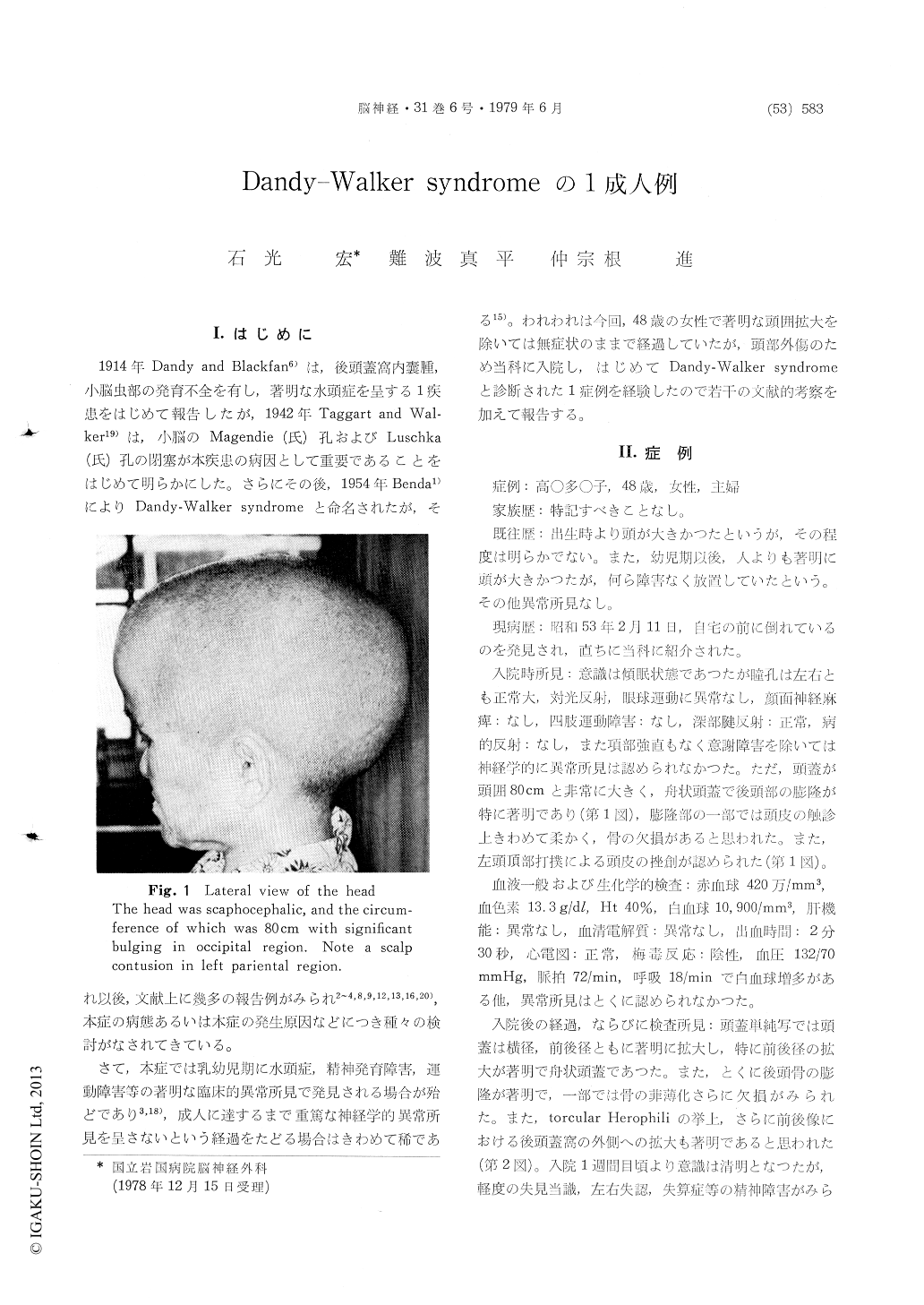Japanese
English
- 有料閲覧
- Abstract 文献概要
- 1ページ目 Look Inside
I.はじめに
1914年Dandy and Blackfan6)は,後頭蓋窩内嚢腫,小脳虫部の発育不全を有し,著明な水頭症を呈する1疾患をはじめて報告したが,1942年Taggart and Wal—ker19)は,小脳のMagendie (氏)孔およびLuschka(氏)孔の閉塞が本疾患の病因として重要であることをはじめて明らかにした。さらにその後,1954年Benda1)によりDandy-Walker syndromeと命名されたが,それ以後,文献上に幾多の報告例がみられ2〜4,8,9,12,13,16,20),本症の病態あるいは本症の発生原因などにつき種々の検討がなされてきている。
さて,本症では乳幼児期に水頭症,精神発育障害,運動障害等の著明な臨床的異常所見で発見される場合が殆どであり3,18),成人に達するまで重篤な神経学的異常所見を呈さないという経過をたどる場合はきわめて稀である15)。われわれは今回,48歳の女性で著明な頭囲拡大を除いては無症状のままで経過していたが,頭部外傷のため当科に入院し,はじめてDandy-Walker syndromeと診断された1症例を経験したので若干の文献的考察を加えて報告する。
A 48 year old female was transferred to our hospital on February the 11th with consciousness disturbance presumably following head injury. She was drowsy at admission with no other neurolo-gical deficit.
It was apparently noticed at first glance her head was extremely big. The head was scaphocephalic in shape, the circumference of which was 80 cm with significant bulging in occipital region. Re-markable enlargement of posterior fossa with ele-vation of the torcular Herophili and bulging of thinned occipital bone was demonstrated by plain skull X-P examination. Her consciousness became alert after residual moderate disorientation disap-peared in two weeks of admission.
Detail examination was performed to make the exact diagnosis of basic intracranial defect causing remarkable head enlargement. Bilateral retrograde brachial angiography (BAG) demonstrated a large avascular area which occupied two third of the space of posterior fossa in angiography, and signi-ficantly elevated superior cerebellar arteries. Addi-tionaly, hypoplastic posterior inferior cerebellar arteries were markedly depressed and intermingled (capillary blush) anteroinferiorly to the avascular area. Pneumoventriculography revealed symmetri-cal enlargement of bilateral ventricles. CT ex-amination demonstrated a large cyst, and residual two nodules which were separated from each other anterolaterally to the cyst. With In-111-cisterno-graphy, neither ventricular reflux nor reflux into the cyst of the posterior fossa was demonstrated, showing noncommunicating hydrocephalus in this case. From these examination, Dandy-Walker synd-rome was most suspected.
In this reported case, the age of the patient was 48 year old when she was first examined in detail to be diagnosed as to Dandy-Walker syndrome, furthermore clinical neurological deficit which made her admit the hospital was thought to be caused by the head injury. Such a late appearance of clinical symptoms of Dandy-Walker syndrome was discussed as well.

Copyright © 1979, Igaku-Shoin Ltd. All rights reserved.


